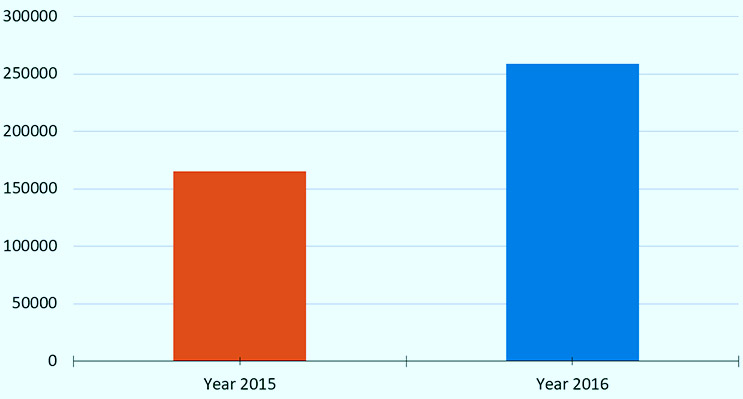Fact sheet 03-2016
M-health Apps by Numbers
Downloadable PDF
The number of mobile phone subscriptions by the end of 2015 almost equalled the world population of seven billion people [1]. This level of reach combined with the exceptional information processing capabilities of smartphones has paved the way for the emerging field of mobile health. World Health Organization (WHO) defines mobile health, m-health, as the medical and public health practice supported by mobile devices, such as mobile phones, patient monitoring devices, personal digital assistants (PDAs), and other wireless devices [2].

M-health applications (apps) have seen a considerable growth over the past few years. According to the latest m-health app report by Research2Guidance, there has been a 57% growth in the number of m-health apps published in major app stores in 2016 [3]. Google Play (for Android devices) currently displays 105,000 m-health related apps in the Health & Fitness and Medical categories, while Apple’s App Store (for iOS devices) displays 126,000. Adding the stores for other platforms such as Windows Phone and Blackberry will raise the number of total m-health apps to 259,000 [3].
While the majority of m-health apps can be regarded as general health and fitness tools, there is an increasing number of apps that target patients with chronic conditions such as diabetes and chronic heart failure. As of April 2013, there are 656 diabetes apps on both major app stores [4]. These apps offer a variety of functionalities such as documentation 53%, communication 31.1%, information 34.5%, analysis 17.8%, recipe suggestion 14.5%, reminder 11.4% and advisory/therapeutic support 8.8% [4].
Chronic heart failure (CHF) m-health apps, on the other hand, seem to be at an earlier stage of development and adoption. As of 2016, there are only 34 m-health apps that are designed for CHF interventions [5]. Apart from chronic disease management, cancer prevention, detection, and management is another area with increasing attention from m-health app publishers.
A recent systematic review [6] of cancer related m-health apps identified 295 apps, with the majority of apps targeting breast cancer (46.8%) or cancer in general (28.5%). The apps were predominantly focused on raising awareness (32.2%) or providing educational information (26.4%), followed by supporting fundraising efforts (12.9%), assisting in early detection (11.5%), promoting a charitable organization (10.2%), supporting disease management (3.7%), cancer prevention (2.0%), or social support (1.0%).

Mental health and addiction is another area that m-health apps have proven to be effective as behaviour change and psycho-educational tools [7]. Smoking cessation m-health apps, for instance, use behaviour change techniques in the design of m-health apps to help people quit smoking or use of snuff. As of 2014, there are 309 such apps, e.g. the Norwegian Slutta app [8], on major app stores [9]. Published by the Norwegian Directorate of Health, Slutta uses daily motivational messages as an example of a feature facilitating behaviour change [8]. Depression, anxiety and alcohol addiction are other areas of mental health that are the focus of m-health app development efforts [6].
References
- International Telecommunication Union. ICT Facts & Figures: The world in 2015. International Telecommunication Union. 2015. URL:https://www.itu.int/en/ITU-D/Statistics/Documents/facts/ICTFactsFigures2015.pdf. Adgang: 2016-11-08. (Arkivert av WebCite® i http://www.webcitation.org/6ls80qa81)
- World Health Organization. mHealth: New Horizons for Health through Mobile Technologies. World Health Organization. 2011. URL:http://apps.who.int/iris/bitstream/10665/44607/1/9789241564250_eng.pdf. Adgang: 2016-11-08. (Arkivert av WebCite® i http://www.webcitation.org/6ls8TTh6t)
- Research 2 Guidance. mHealth App Developer Economics 2016. Research 2 Guidance. 2016. URL:http://research2guidance.com/product/mhealth-app-developer-economics-2016/. Adgang: 2016-10-26. (Arkivert av WebCite® i http://www.webcitation.org/6lY0vJ78i)
- Arnhold M, Quade M, Kirch W. Mobile Applications for Diabetics: A Systematic Review and Expert-Based Usability Evaluation Considering the Special Requirements of Diabetes Patients Age 50 Years or Older.J Med Internet Res 2014;16(4):e104.URL: http://www.jmir.org/2014/4/e104. DOI: 10.2196/jmir.2968. PMID: 24718852. PMCID: 4004144
- Creber RM, Maurer MS, Reading M, Hiraldo G, Hickey KT, Iribarren S. Review and Analysis of Existing Mobile Phone Apps to Support Heart Failure Symptom Monitoring and Self-Care Management Using the Mobile Application Rating Scale (MARS). JMIR mHealth and uHealth. 2016 Apr;4(2).
- Bender JL, Yue RYK, To MJ, Deacken L, Jadad AR. A Lot of Action, But Not in the Right Direction: Systematic Review and Content Analysis of Smartphone Applications for the Prevention, Detection, and Management of Cancer. J Med Internet Res 2013;15(12):e287. URL: http://www.jmir.org/2013/12/e287. DOI: 10.2196/jmir.2661. PMID: 24366061. PMCID: 3875901
- Chan SR, Torous J, Hinton L, Yellowlees P. Mobile tele-mental health: increasing applications and a move to hybrid models of care. Healthcare 2014 May 6 (Vol. 2, No. 2, pp. 220-233). Multidisciplinary Digital Publishing Institute.
- Helsedirektoratet. Slutta. Helsedirektoratet. 2015. URL:https://helsenorge.no/rus-og-avhengighet/snus-og-roykeslutt/fa-hjelp-til-a-slutte-med-app-chat-og-pa-nett. Adgang: 2016-11-07. (Arkivert av WebCite® i http://www.webcitation.org/6lqtrSBUc)
- Choi J, Noh GY, Park DJ. Smoking Cessation Apps for Smartphones: Content Analysis With the Self-Determination Theory. J Med Internet Res 2014;16(2):e44. URL: http://www.jmir.org/2014/2/e44. DOI: 10.2196/jmir.3061. PMID: 24521881. PMCID: 393627